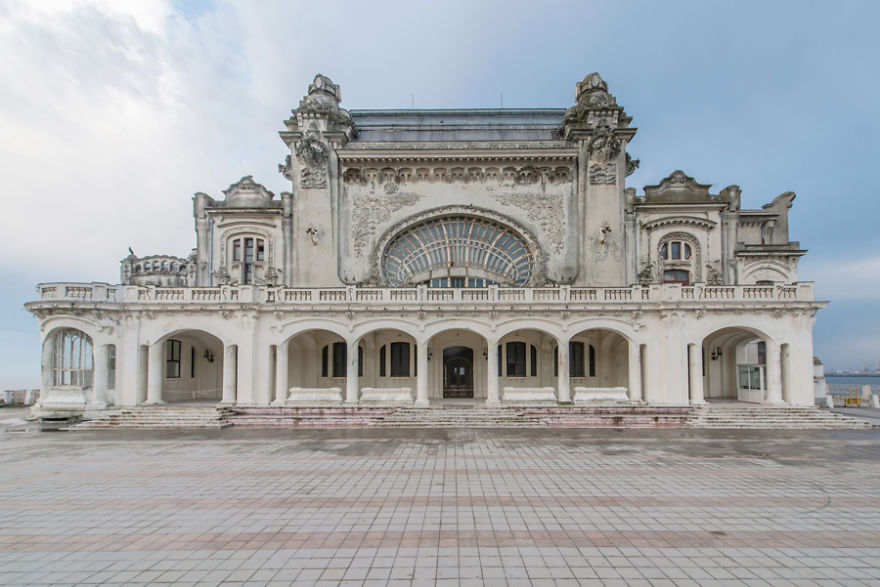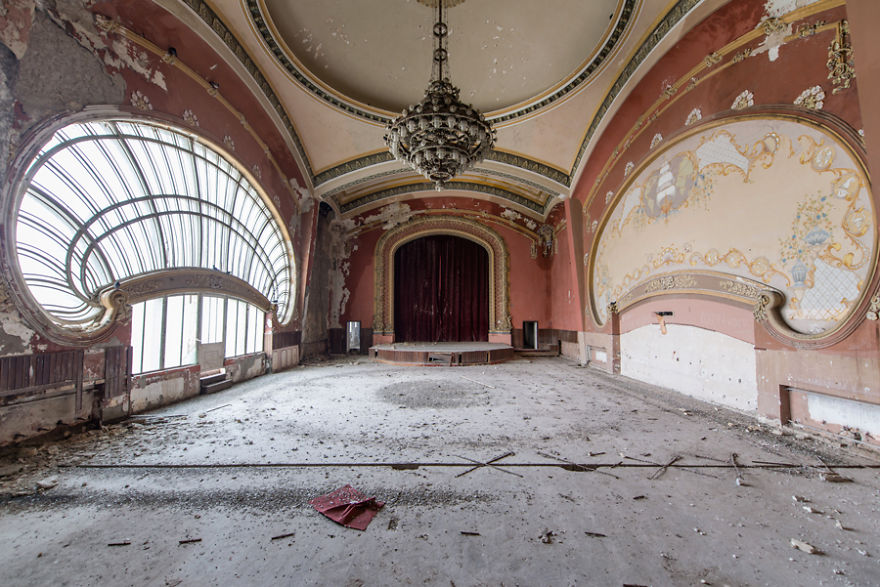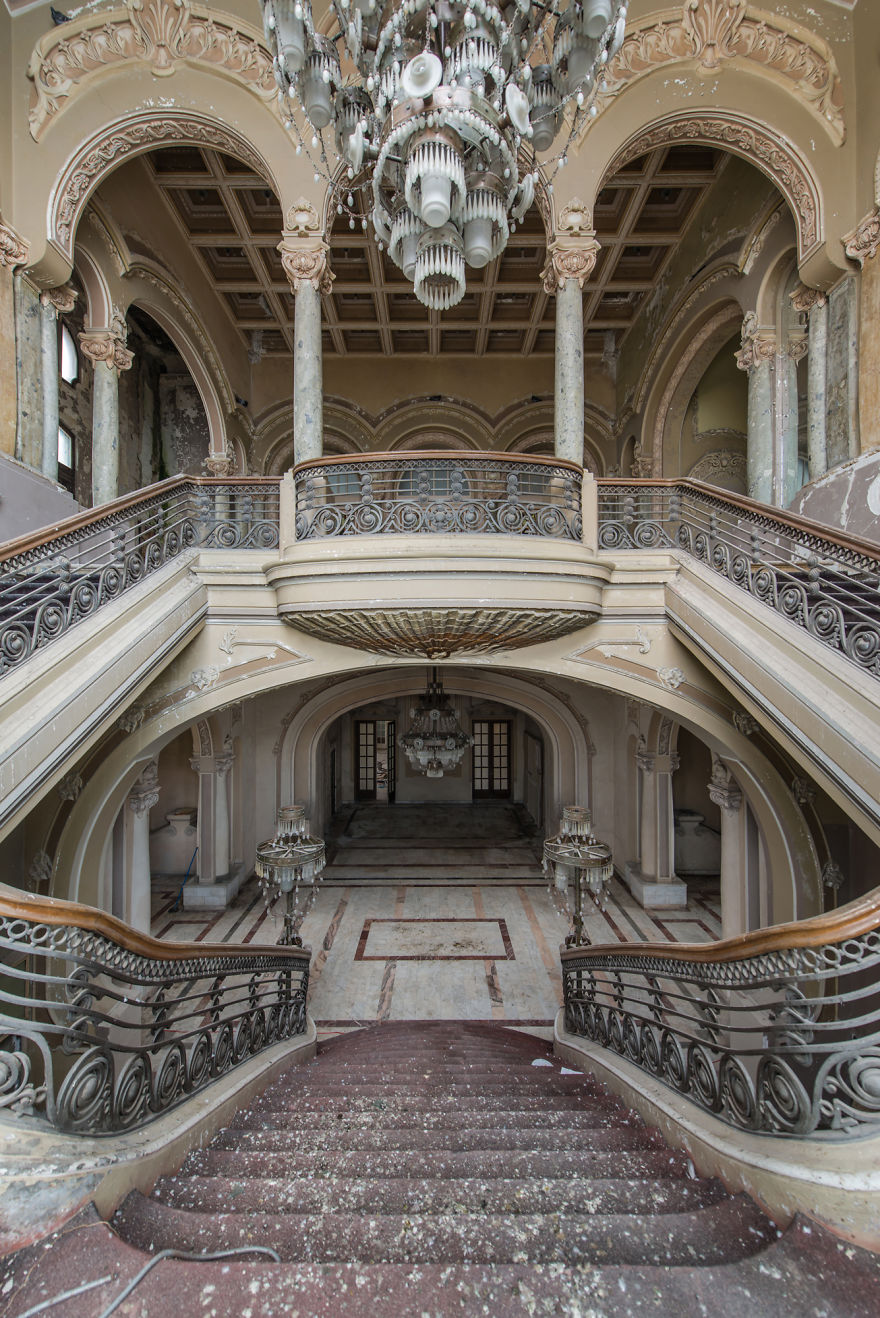
Historical Background
Early Years
Commission and Construction: Initiated in the early 20th century under the reign of King Carol I, the Constanța Casino was built to reflect the growing prosperity and modernization of Romania. It replaced an earlier, more modest casino structure from 1880.
Grand Opening: The casino officially opened in 1910 and quickly became a beacon of cultural and social life in Constanța, hosting lavish parties, concerts, and social gatherings.
Interwar Period
Cultural Hub: During the interwar years, the casino reached its peak, drawing in an international clientele. It was a place where the wealthy and influential from across Europe mingled, reinforcing its status as a premier destination.
Renovations and Upgrades: The building underwent several enhancements to keep up with its prestigious status, including updates to its interiors and facilities.
Architectural Significance
Design Elements
Art Nouveau Style: The casino is a quintessential example of the Art Nouveau style, noted for its fluid, organic forms, and intricate detailing. The design reflects a blend of elegance and extravagance, characterized by decorative motifs inspired by natural elements like flowers and plants.
Prominent Features: Key architectural features include the grand staircase, large stained-glass windows, elaborate chandeliers, and finely detailed stucco work. The building’s façade is adorned with ornamental carvings and sculptures, showcasing the craftsmanship of the era.
Structural Layout
Main Hall: The heart of the casino is its grand ballroom, which once hosted dances, banquets, and concerts. The space is distinguished by its high ceilings and opulent decor.
Gaming Rooms: Various rooms were dedicated to different games, including roulette, poker, and baccarat, each designed to offer a luxurious and immersive experience for patrons.
Decline and Abandonment
War Impact
World War I and II: The casino’s operations were significantly disrupted by the wars. It was repurposed for military use, first as a hospital and later as a base, which led to significant wear and tear.
Post-War Neglect: After World War II, Romania’s shift to a communist regime led to further neglect. The building was nationalized and saw various uses, none of which included the necessary maintenance to preserve its condition.
Attempts at Revival
1980s Restoration Efforts: There were some attempts to restore the casino in the late 20th century, but these were largely insufficient and short-lived due to economic and political challenges.
Continued Deterioration: By the turn of the century, the building was largely abandoned, its magnificent interiors succumbing to the ravages of time and exposure to the elements.
Current State and Future Prospects
Restoration Initiatives
Recent Efforts: In the past decade, there has been a renewed interest in preserving and restoring the Constanța Casino. Various funding initiatives, including EU grants, have been proposed to support restoration projects.
Architectural Assessments: Detailed architectural assessments have been conducted to plan the restoration work, aiming to return the casino to its former glory while updating it to modern standards of safety and accessibility.
Cultural and Economic Impact
Tourist Attraction: Even in its dilapidated state, the casino remains a key attraction, drawing visitors interested in its history and architecture. Successful restoration could significantly boost tourism and local economy.
Symbol of Heritage: Restoring the casino would also serve as a powerful symbol of Romania’s commitment to preserving its cultural heritage, offering a tangible link to the past and an inspiration for future generations.
Vision for the Future
Cultural Venue: There are plans to repurpose the restored casino as a multifunctional cultural venue, hosting exhibitions, concerts, and social events. This would not only honor its historical role but also ensure its sustainability.
Community Involvement: Engaging the local community in the restoration process is seen as vital, fostering a sense of pride and ownership over this historic landmark.
In summary, the Constanța Casino stands as a testament to Romania’s architectural and cultural legacy. Its restoration promises to revive not only a magnificent building but also a vital piece of the nation’s history, ensuring it continues to inspire and captivate for generations to come.

Foundation and Early Days
Conceptualization: The idea of building a grand casino in Constanța emerged in the late 19th century as part of a broader vision to modernize the city and transform it into a fashionable seaside resort. This vision was fueled by the increasing popularity of the Black Sea coast as a destination for leisure and recreation.
Early Structure: Before the current casino, a simpler wooden structure served as the city’s casino. It quickly became outdated and inadequate to meet the growing expectations of visitors.
Grand Opening and Operation
Inauguration: The Constanța Casino was inaugurated on August 15, 1910. The opening ceremony was a grand affair, attended by local dignitaries and international guests, showcasing Romania’s commitment to elegance and culture.
Social Hub: The casino’s early years saw it become a central hub for social and cultural life in Constanța. It hosted balls, theater performances, and concerts, drawing prominent figures from Romania and beyond.
Architectural Significance
Design and Aesthetics
Architectural Vision: Daniel Renard, the primary architect, designed the casino in the Art Nouveau style, a choice that reflected the contemporary trends in European architecture. His vision was to create a building that was both functional and artistically ambitious.
Exterior Details: The building’s façade features elaborate decorations, including floral and nautical motifs, symbolizing its seaside location. The sweeping curves and ornamental details are quintessential elements of Art Nouveau design.
Interior Grandeur: Inside, the casino was designed to exude luxury. Marble columns, intricate mosaics, and rich woodwork adorned the interiors. The grand staircase and the ballroom were particularly notable for their opulence.
Structural Challenges
Construction Difficulties: Building such an elaborate structure on the seafront presented significant challenges, including the need to protect it from the corrosive effects of saltwater and sea air. Advanced engineering techniques of the time were employed to ensure its durability.
Decline and Abandonment
Wartime Usage
World War I: During the First World War, the casino was converted into a hospital. This shift in use led to significant wear and damage, as the building was not designed for such heavy-duty purposes.
Interwar Period: Post-war, the casino was partially restored and reopened, but the interwar years were marked by economic challenges that limited its operation and maintenance.
World War II and Communist Era
Second World War: The casino suffered further damage during World War II, including bombardments. It was again repurposed for military use, exacerbating its decline.
Communist Neglect: Under the communist regime, the casino was nationalized. The new government prioritized industrial and utilitarian projects over cultural and leisure facilities. The casino saw minimal maintenance and was used for various purposes, none of which honored its original splendor.
Cultural Significance
Symbol of Elegance
Historical Landmark: Despite its current state, the Constanța Casino is still regarded as an architectural jewel of Romania. It symbolizes a bygone era of elegance and sophistication, reflecting the city’s historical importance as a cultural center.
Film and Photography: The casino’s haunting beauty has made it a popular subject for filmmakers and photographers. It has been featured in various documentaries, films, and photography projects, highlighting its cultural resonance.
Restoration Efforts
Government and Private Initiatives
Funding Challenges: Securing funds for restoration has been a significant hurdle. However, both national and local governments have recognized the importance of restoring the casino. European Union grants and private donations have also been sought to support the restoration efforts.
Phased Restoration: The restoration is planned in phases, starting with stabilizing the structure to prevent further decay, followed by restoring the exterior and, finally, the interior.
Architectural Restoration Plan
Preservation of Original Elements: A key aspect of the restoration is preserving the casino’s original architectural elements. This includes meticulously restoring the ornamental details and structural features to their former glory.
Modern Upgrades: The restoration will also incorporate modern amenities to ensure the building’s functionality as a contemporary venue, including upgrades to plumbing, electrical systems, and accessibility features.
Future Prospects
Vision for Revitalization
Cultural Venue: Once restored, the casino is envisioned as a multifunctional cultural venue. It will host a range of events, from art exhibitions and concerts to conferences and weddings, making it a vibrant part of Constanța’s cultural landscape.
Economic Boost: Revitalizing the casino is expected to boost local tourism and the economy. It will attract both domestic and international visitors, contributing to the city’s development.
Community Engagement
Local Involvement: Engaging the local community in the restoration process is crucial. Initiatives such as public consultations, volunteer programs, and educational workshops aim to foster a sense of ownership and pride among residents.
Cultural Programming: The restored casino will also serve as an educational and cultural hub, offering programs that celebrate the city’s heritage and promote the arts.
Conclusion
The Constanța Casino is more than just an abandoned building; it is a symbol of Romania’s rich cultural and architectural heritage. Its restoration represents a bridge between the past and the future, promising to revive a piece of history for new generations to enjoy. The ongoing efforts to restore this iconic landmark reflect a broader commitment to preserving cultural heritage and revitalizing community spaces, ensuring that the Constanța Casino remains a treasured part of Romania’s architectural legacy.

Social and Cultural Impact
Elite Social Scene
High Society Gathering: In its heyday, the Constanța Casino was the epicenter of the social scene for Romania’s elite. Aristocrats, politicians, and wealthy businesspeople frequented the casino, making it a symbol of social status and sophistication.
Cultural Events: The casino hosted a myriad of cultural events, including operas, theater performances, and classical music concerts. These events were often attended by luminaries from across Europe, further enhancing the casino’s reputation.
Symbol of Modernity
Technological Advancements: The construction of the casino represented the modernization of Constanța, incorporating advanced building techniques and materials for its time. Its design and amenities symbolized the city’s progress and its aspiration to be on par with other major European cities.
Urban Development: The casino’s presence spurred the development of the surrounding area, leading to the establishment of luxury hotels, restaurants, and other entertainment venues, contributing to the urbanization of Constanța.
Architectural Features in Detail
Exterior Design
Façade Details: The casino’s exterior is adorned with intricate carvings and reliefs depicting marine life and mythological figures, reflecting its coastal location. The façade also features large, arched windows that provide breathtaking views of the Black Sea.
Balconies and Terraces: The building boasts multiple balconies and terraces, designed for social gatherings and offering panoramic views of the sea and the city. These outdoor spaces were integral to the casino’s social functions.
Interior Design
Grand Staircase: One of the most iconic features of the casino is its grand staircase, which served as a focal point for guests entering the building. The staircase is made of marble and features elaborate railings and balustrades.
Ballroom: The ballroom is the centerpiece of the casino’s interior. With its high ceilings, chandeliers, and ornate decorations, it was designed to impress and host grand events. The space is framed by large windows that flood the room with natural light.
Gaming Rooms: Various rooms dedicated to different games were designed with luxurious furnishings and decorations. Each room had its own distinct style, contributing to the overall opulence of the building.
Detailed Restoration Process
Preliminary Assessments
Structural Analysis: Before any restoration work could begin, detailed structural analyses were conducted to assess the extent of the damage and determine the necessary repairs. This included studies of the building’s foundation, walls, and roof.
Historical Research: Extensive research into historical documents, photographs, and original architectural plans was undertaken to ensure the restoration would be true to the original design.
Stabilization Efforts
Preventing Further Decay: The first phase of restoration focused on stabilizing the building to prevent further deterioration. This included reinforcing the foundation, repairing the roof, and sealing the structure against water damage.
Temporary Supports: Temporary supports and scaffolding were erected to protect the building during the restoration process and to allow workers to safely access all areas.
Restoring Architectural Elements
Exterior Restoration: The exterior of the casino was meticulously cleaned and restored. This included repairing damaged carvings and reliefs, replacing broken windows, and restoring the original color scheme.
Interior Restoration: Inside, the restoration team focused on preserving and restoring original features such as woodwork, mosaics, and plasterwork. Specialized craftsmen were employed to recreate the intricate details that had been lost over the years.
Chandeliers and Lighting: Original light fixtures and chandeliers were either restored or replicated based on historical photographs. Modern lighting systems were discreetly integrated to enhance the building’s functionality without compromising its historical integrity.
Future Prospects and Uses
Multifunctional Venue
Cultural Hub: The restored casino is envisioned as a cultural hub, hosting a wide range of events including art exhibitions, theater performances, and music concerts. This will honor its historical role as a center of cultural activity.
Conference and Event Space: The casino will also serve as a venue for conferences, weddings, and other social events, providing a unique and historic setting for gatherings.
Economic and Social Benefits
Tourism Boost: The restoration is expected to significantly boost tourism in Constanța. The casino’s historical and architectural significance will attract visitors from around the world, contributing to the local economy.
Job Creation: The project will create jobs both during and after the restoration. This includes construction and restoration work, as well as roles in the management and operation of the venue once it reopens.
Community Engagement
Educational Programs: The restored casino will offer educational programs and tours to engage the community and visitors with its history and architecture. These programs will be designed to raise awareness about the importance of heritage preservation.
Public Involvement: Community involvement is key to the project’s success. Initiatives such as volunteer programs and public consultations aim to foster a sense of ownership and pride among local residents.
Conclusion
The restoration of the Constanța Casino is a monumental project that bridges Romania’s rich past with its promising future. This iconic building, once a symbol of elegance and modernity, stands on the cusp of a new era. Its revival will not only preserve a significant piece of architectural heritage but also breathe new life into the cultural and social fabric of Constanța. As restoration efforts progress, the casino is poised to reclaim its status as a premier destination, offering a unique blend of historical charm and contemporary functionality. The project exemplifies the enduring value of heritage preservation and the transformative power of restoring iconic landmarks.
